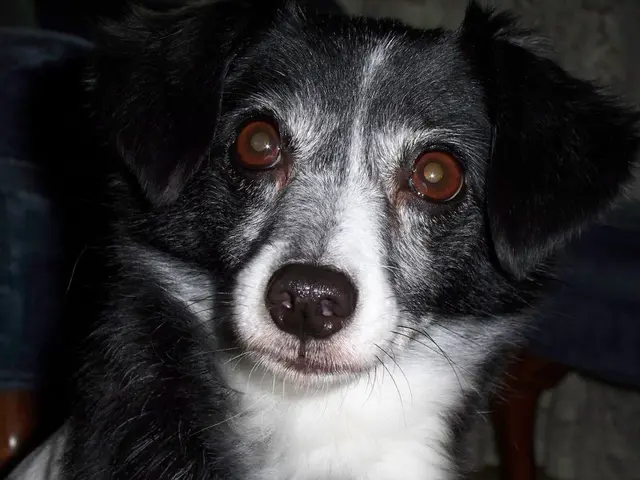Scientists suggest a deeper level of communication among dogs than previously thought, as they propose that dogs may employ blinking as a means to establish social connections, much like humans and primates do.
Lightning-fast Bonding: The Unexpected Dog Move You Didn't Know About
Ever noticed your pooch blinking in sync with you or that special someone? What about those times when Fido seems to be mirroring your own facial expressions during a heated moment at the dog park? Believe it or not, it's all part of the canine communication game, and it's called synchronous blinking. While this might sound like a strange concept, it's actually quite fascinating and could be significant for bonding between humans and dogs.
New research sheds light on the canine blinking phenomenon. Researchers from the University of Parma, Italy, recently published a study in Royal Society Open Science[1], highlighting that dogs are not only more likely to blink around other dogs, but they might be mimicking each other's blinks in a subconscious bid to strengthen social bonds.
Martina Francesconi, an ethologist at the University of Pisa and not involved in the study, had this to say, "It seems our dogs might be more in sync with one another than we've realized[3]."
The Power of Synchronized Blinking
Prior studies on dogs indicated that they blink more frequently around dogs and even humans, and that blinking can help de-escalate tensions[2]. Dogs also display similar behaviors such as yawning, when other dogs engage in the same actions - known as facial mimicry.
Chiara Canori, an evolutionary biologist from the University of Parma, wanted to find out whether blinking was part of the race to mimicry. She created short videos of dogs, watching a toy or treat behind the camera, both blinking and not blinking as well as licking their noses – a sign of frustration or excitement. The videos were combined into 71-second clips and shown in random order to 54 pet dogs of various breeds, all wearing heart monitors.
While some doggos dozed off, the others blinked approximately 16% more on average when watching a dog blinking, with no signs of stress detected. This suggests that dogs might be mimicking the on-screen blinkers[1].
The Future of Fido's Blinks
Canori mentions that future research is needed to determine if the dogs' blinks were synchronized with the on-screen blinkers, and if so, how quickly they responded[1]. However, the increase in blink frequency does hint that unconscious mimicry or synchronized behavior is at work.
It's worth noting that blinking is a reflex, and dogs probably don't realize they're doing it[1]. Instead, it's a behavior that has likely evolved over time to help them navigate social situations. If you're hoping to strengthen your pup's bond with you, giving the 32 ways to improve your relationship with your dog or the things your pet is trying to tell you a shot might not be a bad idea[4].
[1] Royal Society Open Science[2] Cell Press[3] Science Magazine[4] Our website Newsletter
- Dogs might not only be mirroring each other's blinks but also yawning, as a form of facial mimicry, in an attempt to strengthen social bonds.
- New studies suggest that dogs may blink more frequently around other dogs and humans, and blinking could potentially help de-escalate tensions.
- Chiara Canori, an evolutionary biologist from the University of Parma, found that dogs blink more on average when watching a dog blinking, implying possible unconscious mimicry or synchronized behavior.
- Future research will seek to determine if dogs' blinks are synchronized with the on-screen blinkers and how quickly they respond, highlighting the importance of the study in understanding canine behavior.
- To strengthen the bond with your dog, you might want to consider exploring ways to improve your relationship with your pet or understanding what your pet is trying to communicate, as these behaviors might play a significant role in their lifestyle and health-and-wellness.








